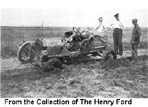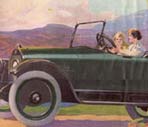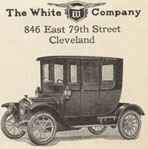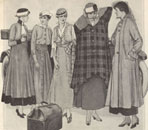
Femininity and the Electric Car
The Electric Car as a “Woman’s” Vehicle
That many people subsumed a variety of ideological, economic, familial, political, and spatial relations under the heading of “separate spheres” testified to Americans’ tenacity in using gender to order experience. But however powerfully evocative, this image vastly oversimplified both human relations and social forces. Sometimes people act in accordance with gender prescriptions; sometimes they do not. Men, supposedly rugged, seek shelter from the rain. Women, supposedly soft-spoken, yell at their children. Men and women continually revised both their actions and their expectations, more often by the minute adjustments of private negotiation than by legal fiat or national proclamation. Through the small changes of personal life, leading to larger transformations on a social scale, activities and entities assigned to one sphere or the other, considered appropriate for either women or men, sometimes lost or recast their gendered meanings. When women refused to conform to expectations, when new technologies unsettled traditional assumptions, when entrepreneurs defied common wisdom in search of profits, change accelerated.
All three forces—female nonconformity, technological innovation, and economic competition—were very much in play in the first third of the century, and the future of the car culture was far from clear. Consumers, engineers, and businessmen would interact in ways no one could predict precisely. In the years before 1920, Americans used all kinds of transportation: their own legs, mules and horses, trains and trolleys, and electric, gas, and steam automobiles. Each method had benefits and drawbacks. Supporters of electric motorcars were at least as inclined to point out the electric’s advantages over the horse and buggy as they were to compare electric and gas vehicles. C. H. Claudy, an early and staunch advocate of electric vehicles (he would later become the automotive columnist for the Woman’s Home Companion), had written in 1907 that the electric car “now does more work, in certain lines, than horses ever did.” Claudy claimed the electric would be a boon to all women, asking whether there had “ever been an invention of more solid comfort to the feminine half of humanity than the electric carriage?” He observed that the woman who drove an electric “finds it very convenient to call up the garage, have her runabout sent around instantly and not have to wait for a complicated hitching or a currying and combing of horses.”
Although Claudy staunchly supported women’s driving, he was slow to recommend gasoline cars for women. Describing the electric as “the car which has a circumscribed radius,” he joined the ranks of those who envisioned the electric in terms of woman’s special, yet limited, sphere. Women, he believed, might use electrics to accomplish the social and domestic tasks that were part of the middleclass homemaker’s vocation, without overstepping the bounds of feminine propriety. “What a delight it is,” he wrote, “to have a machine which she can run herself, with no loss of dignity, for making calls, for shopping, for a pleasurable ride, for the paying back of some small social debt.” The electric might even be just the thing to reconcile motoring and motherhood. Pointing out that “in no way can a child get so much air in so little time as by the use of the automobile” Claudy declared that “it would not be amiss to call the electric the modern baby carriage. . . . It is the light electric runabout which deserves the title of scientific perambulator.” Thus he painted a rather odd, infantile picture of the woman driver, tucked in alongside her baby in a “scientific perambulator.”
While promoters of electrics tried to forge a positive link between the woman driver and the battery-powered motorcar, an occasional critic suggested that women’s purported deficiencies in driving ought to disqualify them from operating anything more powerful than rather tame electrics. In an article on reckless drivers published in The Outlook, writer Montgomery Rollins drew on the notion that femaleness unfitted some people for the adult responsibility of driving a powerful gasoline automobile. Rollins argued, “It’s no child’s play to run a motor car. No license should be granted to anyone under eighteen . . . and never to a woman, unless, possibly, for a car driven by electric power.”
Against such disparagement of both electrics and women, electric vehicle manufacturers and their supporters worked to protect whatever claim they might have to women motorists, while also struggling to get a foothold in the male market so clearly dominated by gasoline cars. C. H. Claudy believed that electrics would be useful to an elite group of men who might value comfort, cleanliness, and everyday utility over extended range and sportiness. Like others, Claudy assumed that a few fastidious men, such as doctors and some businessmen, would be willing to forego speed and range for the advantages of simple mechanical construction, reliability on short errands, quietness, cleanliness, and simplicity of operation. The implicit corollary of such assumptions was that most men had little desire for the kinds of comforts and conveniences electrics offered, prefer ring a more rugged and vigorous, less restrictive form of motoring. The Detroit company tried in 1910 to counteract the electric fussy feminine image by introducing one of its electric models as a “new car for 'him' . . . a brand-new extra-low and rakish Detroit Electric model for men is our Gentlemen’s Underslung Roadster.” Yet men continued to spurn the electric, quite simply because it did not go far enough or fast enough.
As men registered their indifference to the electric, women were demonstrating their own unwillingness to leave long-distance touring and high-speed driving to men. As a consequence, the application of separate spheres ideology to motive power in automobiles had lost force by 1912, when C. H. Claudy an nounced that “the time has gone by when motor cars had sex—when the gasolene [sic] car was preeminently for the man, and the electric, because of its simplicity, for the women.” Beliefs, however, die hard, and even this exponent of technological progress remained unable to abandon completely the idea that “motor cars had sex..” Once again invoking a female disposition toward convenience, Claudy predicted that “of all the types of self-propelled vehicles, the electric is now, and seems likely to remain, the simplest to handle on the road and to care for at home, whereby it still is, and seems likely to continue to be, the ladies’ favorite.”
Like Colonel Pope before him, Claudy very quickly proved a poor prognosticator. Relating the story of a bride who told her young husband, “I don’t want an electric. I want a car that can go a long distance. I want a car that can go fast, and an electric can’t go either far or fast,” Claudy commented incredulously, “The lady was right in one thing—she did not want an electric. What she wanted was a six-cylinder touring car!” Instead of acknowledging women’s similarity to men in this matter of automotive taste, he set about trying to reconcile female drivers to the more womanly form of motoring. Rather than demanding the speed, range, and hill-climbing power of gasoline vehicles, he advised female motorists to accept the electric’s limitations. Claudy admitted, “A practical electric vehicle cannot be built so that it can go fast and far and climb hills. Speed you can have, or great radius you can have—but not both at once and still keep down weight and cost.” Women, he maintained, had no need for speed:
It can be roundly stated without fear of contradiction that the times a woman wants to run an electric 30 miles an hour, are few and far between. . . . It is an unnecessarily fast speed for pleasure driving. . . . If the car you select has a maximum speed of 25 miles on the level, it goes quite fast enough.
In much the same manner that he had dismissed women’s claim to velocity, he would also disparage women’s desire to cover distance. Claudy explained that “a radius of 60 to 80 miles is ample for any electric car,” stretching the capabilities of the average electric vehicle, and suggesting that women had no need to go further. For women to accept such circumscribed mobility ruled out cross-country travel, or even extended day trips, in an era when gas stations were beginning to dot the countryside, but electric charging stations had not spread beyond major cities. In addition, electric batteries needed servicing so often that they would have forced cross-country travelers to stop more frequently, and for much longer periods of time, than most Americans cared to do, particularly in an era when poor road quality forced more than enough stops for the average traveler. Ignoring such restrictions, Claudy reminded readers of the electric’s ad vantages for women, given their bulky clothing, innate preference for luxury, and inability to learn to shift gears:
Practically all the modern electric cars are arranged with special reference to their ease of control by women—that is, the controlling and reverse levers are (or should be) simple in operation and few in number, they work easily, and are so placed and arranged as not to catch and tear the dress. Besides these points, women naturally choose those cars the interior appointments of which please them the most.
Despite their narrow view of women’s talents and desires we need not blame the electric’s advocates too much for finding virtue in electric automobiles. After all, motorists of any era and either sex might find the qualities of simplicity, convenience, and aesthetic appeal worth having in a motor vehicle. However, when automotive designers and promoters, acting in part under the influence of cultural imperatives regarding gender, coupled these desirable attributes with the electric’s limited power and circumscribed range, they misread their audience. No law of nature dictated that automobiles could not be designed to be comfortable, reliable, handsome, and powerful, qualities that might appeal to men and women alike. And even if automakers continued to insist that males and females had different automotive preferences, a sex-specific promotional strategy made very little business sense in an economy where consumers, male or female, had some choice, and where families buying only one vehicle were likely to have to accommodate male drivers who were presumed to want to go farther and faster than their female counterparts.
Perhaps most damaging, the electric was too cumbersome to manage bad roads. At the turn of the century, few localities in the United States could claim many miles of improved highways. Thus the electric car had limited appeal for motorists of either sex in places where distances were great and paved roads were few. In Tucson, Arizona, for example, twenty-three women owned autos in 1914. Twenty-one of those owned gasoline-powered vehicles, and none of the 402 male car-owners listed in the Tucson Automobile Directory owned electrics. Only one vehicle listed could be definitely identified as an electric, and one other may have been an electric. The Houston, Texas, automobile directory of 1915 revealed that only 30 out of 425 women auto owners had electrics, and most of those appeared to have registered their vehicles in the very earliest years of the car culture. Thus in Houston, by 1915, only one woman car owner in fourteen, or seven percent of the total, had an electric. Even during the electric’s pre-Model T heyday, four out of five women auto owners in Houston had gasoline cars. The economic folly of Claudy’s advice was compounded by the fact that, particularly after Henry Ford’s introduction of the Model T in 1908, numerous gasoline cars were available for prices under $1,500, while electric autos appear to have remained more expensive than gas cars, as the accompanying table indicates.
TABLE 1 SOME PRICES OF ELECTRIC AUTOMOBILES, 1903-1919
Manufacturer |
Price Range (Dollars) |
Year |
Pope-Waverly |
850- 900 |
1903 |
Woods |
2100-2700 |
1909 |
Bailey |
2400-2600 |
1910 |
Hupp-Yeats |
1750 |
1910 |
Waverly |
2250 |
1912 |
Standard |
1850 |
1912 |
Argo |
2500-3100 |
1913 |
Detroit |
2550-3000 |
1913 |
Milburn* |
1285-1685 |
1916 |
Milburn* |
1885 |
1917 |
Milburn* |
1885 |
1918 |
Milburn* |
2385 |
1919 |
Source: Motor magazine, advertisements for electric vehicles including price information, 1903-1920.
*Prices given are for the “Milburn Light Electric,” a model that apparently became more expensive between 1916 and 1919.
The rapidly growing number of women driving gasoline cars did as much to disrupt the link between women and electrics as any force of nature or engineering. By 1913, C. H. Claudy, who had put so much effort into promoting electric vehicles to female drivers, had changed his mind. He had come to believe that many women had both the ability and the determination to drive gas-powered automobiles. Moreover, he recognized that male prejudice, more than female preference, stood in the way of women who wished to drive gas cars. In a piece on “The Woman and Her Car,” Claudy imagined the feelings of a young woman who aspired to the driver’s seat: “Oh, I’d love to have a car, but father doesn’t think I could drive it. He wants me to have an electric, and they don’t go either fast or far enough.” The columnist noted: “Father frequently does think his daughter hasn’t the strength, skill, or natural ability to acquire it, necessary to drive a gasolene car successfully. Many husbands think the same about their wives.” By this time, however, he no longer shared such views, and argued that “there is no reason at all why . . . you [women] cannot drive with pleasure to your friends, as skilfully [sic], as gracefully, and with as obedient a car as anyone, even father, can wish.” Thereafter, in articles for the Woman’s Home Companion, Claudy encouraged women to drive gasoline vehicles, providing sensible advice on motoring and introducing women to the intricacies of auto maintenance. Having placed the gas-powered motorcar within the compass of woman’s sphere, Claudy had also stretched his definition of the feminine. By 1920, he would assert, “The number of women who drive motor cars with skill and enjoyment is sufficient proof that there is nothing in the modern Pegasus which femininity cannot master.” In an effort to keep up with consumers’ chang ing demands, producers would at once modify their notions of gender and the machines they made.
A few gasoline auto manufacturers had long since recognized that there was a female market for their products. They realized that the automobile was unlikely to supersede the horse as a popular mode of transportation until it became a family vehicle, offering power as well as simplicity, range as well as convenience. The Winton Company, promoting its Model C in 1905, declared that “Women Praise the Winton,” a vehicle “ideal for women’s use” because it was “as easily controlled as the best mannered horse,” but “safer, because it cannot scare.” The company also noted that the Model C went “as far, and as fast or as slow, as the lady at the wheel desires.” To prove its point, Winton included testimonials from two women drivers. One had written, “I much prefer my new WINTON to the electric I formerly owned, and its control is fully as perfect. It is a comfort to know that one has the power to go fast or slow as desired. ” Another satisfied female motorist belied the image of women drivers as too feminine to tackle gearshifting, cranking, and simple mechanical work. The ad quoted her to the effect that:
every day since [the Winton] came into our possession it has had no small mileage, and at no time has the engine “missed” an explosion. Neither has there been occasion to make a single adjustment, beyond once retightening the clutch. I have not the slightest difficulty in handling the car—motor has not yet failed to start with a single throw of the crank. I like the magneto. The WINTON system of individual clutch is pleasingly effective, and the control is so delightfully simple that to drive the car—even through congested city thoroughfares, is the easiest thing imaginable.
In 1909, the Maxwell-Briscoe Company also made an effort to market gas-powered cars to families that included women drivers, sending Alice Huyler Ramsey and three women passengers on a highly publicized cross-country drive and mounting an advertising campaign based on the notion of the inexpensive family car. In praise of its Model AA, a “reliable business runabout” priced at $600 to compete with the Ford Model T, the company asserted: “Everyone should own this car, because it fills the universal need. As easy to drive as an electric. Your wife, daughter, or son can run this MAXWELL and care for it — chauffeur is unnecessary.” The Maxwell, advertising copywriters insisted, was much more than a pleasure car for buffs or thrill-seekers: “For errands, shopping, calls, meeting trains taking the children to school, for business or pleasure, this auto mobile is the gateway to outdoors and health. Picture yourself in it—how would you use it?”
By 1910, the White Motor Company had joined Winton and Maxwell-Briscoe in the effort to attract women drivers to gasoline cars. The company promoted its White coupe as “a woman’s town car,” explaining that “most women have felt compelled to drive electric cars—especially in the Winter—because no gasoline car was designed for a woman to drive.” White, however, claimed to have solved this design problem with the “inside drive coupe,” a closed car very much resembling the boxy electric coupes of the day, featuring doors on both sides wide enough to accommodate cumbersome skirts and a driver’s seat that folded up “to make entrance easy from either side.” Calling attention to the car’s “upholstery, electric lights, and the little accessories . . . all of the finest imported materials,” the company insisted that “nothing has been overlooked that could contribute to a woman’s satisfaction in a car which is so particularly designed for her personal use.” While upholding most of the sex-stereotyped ideas about women’s automotive abilities and preferences, such advertisements undermined the exclusive identification of gasoline power with male drivers, thus gently challenging the consignment of women to the realm of the electric-powered vehicle.
<<Previous Section - Next Section>>
Early Automobiles and “Separate Spheres”
The Electric Car as a “Woman’s” Vehicle
About the Project | Credits | Contact Us | Student & Teacher Resources | Site Map
©2004 Automobile in American Life and Society





